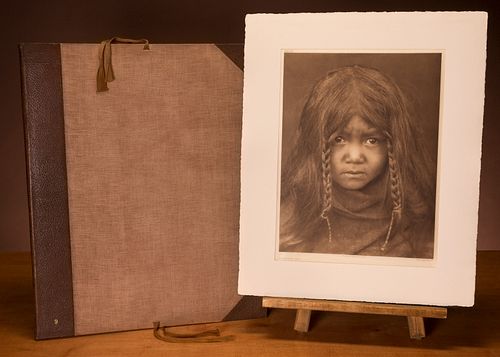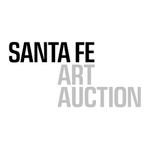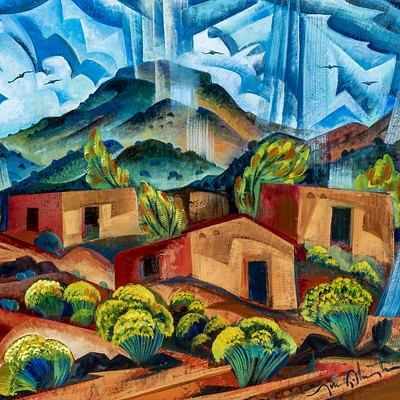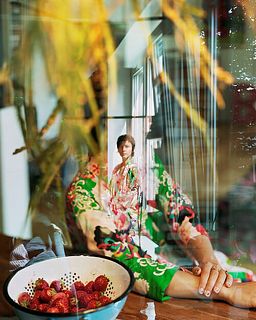Edward S. Curtis, The North American Indian Portfolio IX, 1913
About Seller
932 Railfan Road
Santa Fe, NM 87505
United States
Boasting the third-largest art market in the United States, Santa Fe has long been a destination for new and seasoned collectors. Located in the heart of the city’s historic downtown, and organized in conjunction with the Gerald Peters Gallery, the Santa Fe Art Auction is the Southwest’s premier ann...Read more
Two ways to bid:
- Leave a max absentee bid and the platform will bid on your behalf up to your maximum bid during the live auction.
- Bid live during the auction and your bids will be submitted real-time to the auctioneer.
Bid Increments
| Price | Bid Increment |
|---|---|
| $0 | $100 |
| $2,000 | $250 |
| $5,000 | $500 |
| $10,000 | $1,000 |
| $20,000 | $2,500 |
| $50,000 | $5,000 |
| $100,000 | $10,000 |
About Auction
Nov 5, 2022
2022 SIGNATURE ANNUAL LIVE Session II Santa Fe Art Auction info@santafeartauction.com
- Lot Description
Edward S. Curtis
(1868 - 1952)
The North American Indian Portfolio IX, 1913
36 photogravures on Japanese Gampi tissue with original Van Gelder overmats
signed in the plate below image: E. S. Curtis
Featuring the Salishan, Chimakum, Quilliute and Willapa tribes of the Pacific Northwest.
LIMITED EDITION: This Portfolio is from set #96, printed on handmade Japanese gampi tissue paper, quarto, original ¾ brown crushed levant by H. Blackwell of Boston, over beige linen-covered boards, original gilt lettered, with photogravure plates by John Andrew & Son of Boston after photographs by Edward S. Curtis, edited by Frederick Webb Hodge, Chief of the Bureau of American Ethnology, field research conducted under the patronage of J. Pierpont Morgan.
PORTFOLIO: 36 large format photogravures, including a List of Plates reference that is hand letterpress printed on hand-made paper. Loose bound in a hand-made, 3-flap portfolio.
Before embarking on his thirty-year odyssey of studying and photographing Native Americans in the summer of 1900, Curtis first made photographs of Indians in his adopted Pacific Northwest several years earlier. A professional studio portrait photographer by training, Curtis was also an avid outdoorsman and amateur landscape photographer. It was while pursuing these latter activities in the Puget Sound area surrounding Seattle that he began to photograph Native Americans and their daily life.
He apparently started this work without a great deal of specific ethnographic intention, yet several of his early Native American images won multiple awards. The most acclaimed, “Homeward “, plate 318 in this portfolio, won both national and international accolades in 1898. portrait is that of Princess Angeline, plate 314. Named Kikisoblu, she was the oldest daughter of Chief Seattle, and is believed to have been the first Native American that Curtis photographed. She is also pictured in “The Mussel Gatherer”, plate 313. Curtis created an evocative and unique visual record of North American Indian women, which are very prominent in this portfolio. Shown in portraits, the making of arts and in food gathering, is testament to the fact that Curtis was able to photograph Indian women so frequently, in such a variety of situations and activities and often with great intimacy, is a testament to his strong relationship with Native Americans and the great trust they placed in him.
folio: 23 x 19 in. (58.42 x 48.26 cm.), print: 18 x 22 in. (45.72 x 55.88 cm.)
Edward S. Curtis Studio
William Henry Moore
The Moore Memorial Library
The Christopher G. Cardozo Collection, 2001
Exhibited:
Puget Sound Baskets, Plate 309
Sacred Legacy: Edward S. Curtis and the North American Indian (176 print exhibit), 2000
Edward S. Curtis: 100 Masterworks, 2016
Lummi Type, Plate 320
Sacred Legacy: Edward S. Curtis and the North American Indian (176 print exhibit), 2000
Edward S. Curtis: 100 Masterworks, 2016 - Shipping Info
-
The Santa Fe Art Auction does not offer in-house shipping, with the exception of jewelry, but a selection of local third-party shippers can be found on our website and in the linked release form below. Buyers are required to provide written authorization by submitting a signed shipping release and waiver of liability form, included with our invoice, in order to release property to the third party shipper of Buyer’s choice. Purchases cannot be shipped or released until payment is received in full. https://www.santafeartauction.com/auctions/shipping-form/
-
- Buyer's Premium



 EUR
EUR CAD
CAD AUD
AUD GBP
GBP MXN
MXN HKD
HKD CNY
CNY MYR
MYR SEK
SEK SGD
SGD CHF
CHF THB
THB



















